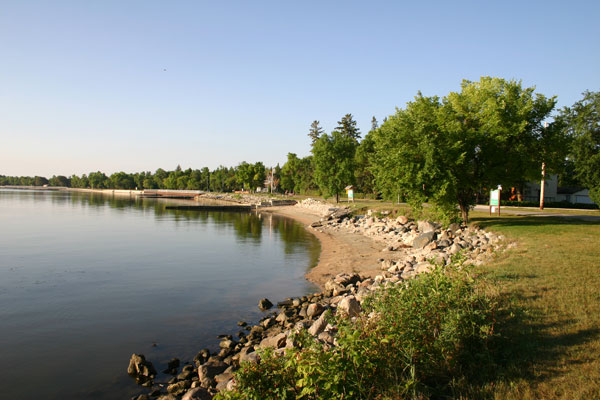Winnipeg Beach is an historic resort town on the shores of Lake Winnipeg. Prospect Street winds its way along the shoreline passing by an assortment of Cottage Country homes. During a series of visits at a rented cabin we had noticed some real differences in driver etiquette between this neighbourhood and our home in Brandon. The well - maintained roadway has more pedestrians and cyclists than it does cars, and all seem to co-exist. At home on our daily walks we routinely encounter unnecessarily loud vehicles, flagrant distracted and aggressive driving, and, of course ...speeding.
None of that behaviour was evident here, even on a busy weekend.

Prospect Street runs along the shoreline, through a residential district in Winnipeg Beach.
Of course it's cottage country, everyone is a bit more relaxed. And the speed limit of 30 kph was well posted. True, the demographics are somewhat different than at home. Far fewer young dudes with large pickup trucks showing off. But it still was a busy enough street in a busy town. It's one thing to try to mandate sensible driving but it's quite another thing to get a high rate of compliance.
I wondered about all this, until I did witness a little roadway incident.
While we were walking downtown, a pickup truck met us, going just a bit too fast. He might not even have been technically exceeding the limit, but the roadway was crowded with kids, bikes, and a few other vehicles. (Just an aside here - apparently many people don't understand the speed limits define the maximum one should drive in ideal conditions. Too many seem to take them as some sort of unconditional right, and express frustration when someone interferes with that right. That guy tailgating you is sending a clear message....you are in his way.)
That's the impression I got as the truck went by. Then someone yelled, "Slow Down!"
You could almost feel the conviction in the voice.
The message was clear. This is our community. These are our kids. We set the rules here, and we're together on this.
And I think that's the secret. We can't just sit back and rely on rules, on government, although both are necessary. We need to own our communities and feel comfortable speaking out in defence of our shared values.
The guy who yelled at the impatient driver did so with the expectation the he could make difference. And he did.
I encourage everyone to check the link I've posted as this week's inspiration.
The main point is that the notion that streets are exclusively for cars is something that was carefully cultivated by the automobile industry. There are many examples of successful inovations that allow for sharing the road.
I'll offer some quotes that I hope will illustrate the message:
"The most recent national data from 2015 show that 283 pedestrians were killed in Canada. In the United States, 5,376 were killed – a 10-per-cent increase over 2014 and the highest pedestrian death toll in almost 20 years."
"Today, lurking unnoticed in the backs of our minds is a certainty: 'Streets are for cars.' But a century ago, the unnoticed certainty was 'streets are for people.'"
As automobiles became common, drivers were routinely blamed for pedestrian deaths. The law, police, social norms and mainstream newspapers all confirmed pedestrians' full rights to streets. They defended even children's rights to them. The responses to pedestrian fatalities included low speed limits, traffic rules that slowed cars down and proposals to restrict cars mechanically to low maximum speeds.
These methods frightened businesses that wanted a large market for automobiles in cities, and they organized to shift the blame for pedestrian fatalities to pedestrians themselves.
In Los Angeles in 1925, local motordom drafted a traffic ordinance that codified automobiles' superior claim to the streets... Thereafter pedestrians, like resident aliens, could enter streets only within strict constraints.
"Assuming that cars must be the priority everywhere has a self-fulfilling effect. When streets are for cars, drivers stop seeing pedestrians – even those who are still there."
"Pedestrians will become visible to drivers only when drivers expect them to be in streets. The success of shared space in several European cities gives us a clear duty at least to consider it for North American cities."
Inspiration....
Look both ways
For pedestrians to be safe, we can't assume that streets are inherently for cars
https://www.theglobeandmail.com/opinion/walking-shouldnt-be-life-threatening-even-for-phonezombies/article37668637/
 |
 |
 |